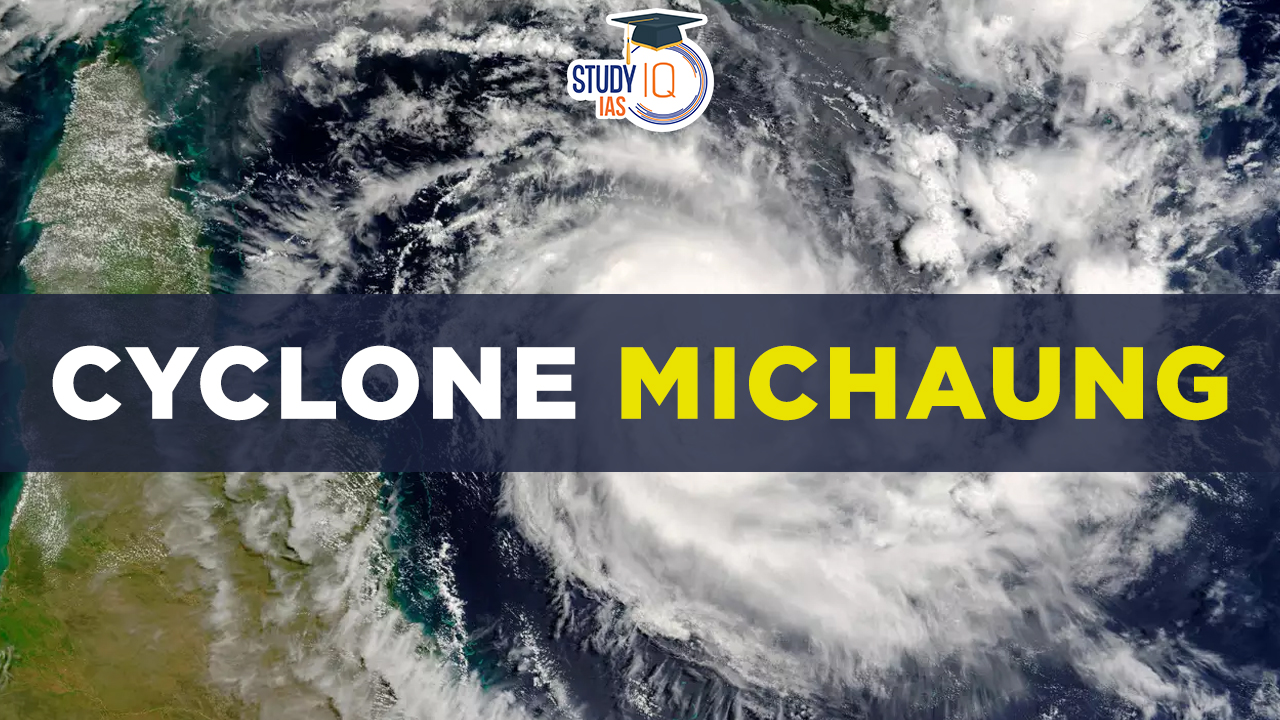Table of Contents
The India Meteorological Department (IMD) has predicted the formation of Cyclone Michaung in the southwest Bay of Bengal, expected to make landfall in coastal districts of Tamil Nadu and Andhra Pradesh on December 4.
Cyclone Michaung
The India Meteorological Department has issued an ‘orange’ alert for Tamil Nadu and Andhra Pradesh as Cyclone Michaung is forecasted to make landfall on December 4. Cyclones, large-scale air systems with spiraling winds, are broadly classified into extratropical and tropical types. Extratropical cyclones, occurring outside the tropics, have cold air at their core and derive energy from the interaction of cold and warm air masses. They are associated with fronts and can develop over land and ocean. In contrast, tropical cyclones, the most destructive storms, form between the Tropics of Capricorn and Cancer, fueled by latent heat from warm ocean waters.
We’re now on WhatsApp. Click to Join
Cyclone in Chennai
Cyclone Michaung, positioned approximately 100 km east-northeast of Chennai, is predicted to escalate into a severe cyclonic storm, With Cyclone Michaung heading towards landfall, regions such as north coastal Tamil Nadu, Puducherry, coastal Andhra Pradesh, Rayalaseema, Telangana, and Odisha are expected to experience varying levels of rainfall. The government’s proactive approach aims to ensure the safety and continuity of essential services during the cyclone’s passage.
Cyclone Michaung in Coastal Regions
The India Meteorological Department (IMD) has issued a forecast for Cyclone Michaung, anticipated to hit the southwest Bay of Bengal on December 3, making landfall in coastal areas of Tamil Nadu and Andhra Pradesh the following day. An ‘orange’ alert has been issued for these regions on Sunday and Monday. Michaung marks the fourth tropical cyclone in the Bay of Bengal this year. Understanding cyclones involves distinguishing between extratropical and tropical cyclones.
Cyclone Michaung Path
Tropical cyclones typically initiate a westward trajectory due to prevailing easterly winds near the equator. As they gain latitude, these cyclones experience the Coriolis effect, causing a slight poleward shift. Eventually, these storms can venture into regions characterized by westerly winds prevalent in the middle latitudes. This transition marks a crucial phase in a cyclone’s track, influencing its trajectory and potential impact on coastal areas. The interplay between easterly and westerly winds guides the complex path of tropical cyclones, impacting weather patterns and posing challenges for accurate forecasting and disaster preparedness.
Cyclone Michaung Landfall
Cyclone Michaung is expected to make landfall in coastal Andhra on December 5. It is also expected to make landfall along the north Tamil Nadu coast, between Nellore and Machilipatnam, on December 4. The cyclone is expected to bring heavy rains to Tamil Nadu and Andhra.
The India Meteorological Department (IMD) has forecast a cyclonic storm, Cyclone Michaung, over the southwest Bay of Bengal. The cyclone is expected to have winds reaching speeds of 100 kmph. A red alert has been issued for the Tiruvallur district for Monday, saying it may receive extremely heavy rainfall.
What is Cyclone?
A cyclone is a large-scale atmospheric system characterized by a low-pressure center around which air circulates counterclockwise in the Northern Hemisphere and clockwise in the Southern Hemisphere. Cyclones can bring about violent storms and adverse weather conditions. They are classified into two main types: extratropical cyclones and tropical cyclones.
What are extratropical cyclones?
Extratropical cyclones, also referred to as mid-latitude cyclones, manifest outside the tropics, beyond the regions defined by the Tropic of Cancer and the Tropic of Capricorn. These cyclones have a central core of cold air and derive their energy from the potential energy released during the interaction of cold and warm air masses, as explained by the US National Oceanic and Atmospheric Administration (NOAA).
Additionally, extratropical cyclones are characterized by the presence of one or more fronts, which serve as weather systems delineating the boundary between warm and cold air masses. These cyclones can impact both land and ocean environments.
What are tropical cyclones?
Tropical cyclones, the most destructive storms on Earth, form in the regions between the Tropics of Capricorn and Cancer. NOAA explains that these cyclones develop as thunderstorm activity intensifies near the center of circulation, with the strongest winds and rainfall concentrated close to the center.
The core of the storm becomes warm, and the cyclone derives most of its energy from the “latent heat” released when water vapor, evaporated from warm ocean waters, condenses into liquid water. Unlike extratropical cyclones, tropical cyclones are not associated with warm fronts or cold fronts.
They are known by different names, such as hurricanes in the Caribbean Sea, Gulf of Mexico, North Atlantic Ocean, and the eastern and central North Pacific Ocean, while in the western North Pacific, they are referred to as typhoons.
Cyclone Michaung UPSC
Cyclone Michaung is forecasted to make landfall in coastal Tamil Nadu and Andhra Pradesh on December 4, prompting an ‘orange’ alert. It marks the fourth tropical cyclone in the Bay of Bengal this year. The cyclone’s path is influenced by prevailing easterly winds, and it is expected to bring heavy rains, with winds reaching 100 kmph. An impending red alert for Tiruvallur district warns of extremely heavy rainfall. The distinction between extratropical and tropical cyclones lies in their core characteristics and locations. Tropical cyclones, fueled by warm ocean waters, are the most destructive storms, while extratropical cyclones derive energy from the interaction of cold and warm air masses.


 India to Host First Global Conference on...
India to Host First Global Conference on...
 How Terror Networks Abuse Digital Tools
How Terror Networks Abuse Digital Tools
 United Nations Population Award 2025: Va...
United Nations Population Award 2025: Va...





















